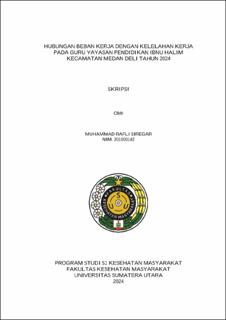| dc.description.abstract | The problem of work fatigue does not only occur in workers in the industrial sector. Fatigue also occurs among teachers and lecturers in the education sector. According to Prihatini dkk.'s research findings at 2023, 87% of the 15 teachers in the PIKPG reported experiencing symptoms of fatigue. This study employs an analytical approach with a cross-sectional research design and quantitative research methods. 45 teachers from kindergarten, elementary, and middle schools made up the study's sample. A subjective fatigue questionnaire based on the Industrial Fatigue Research Committee (IFRC) scale was used to measure and categorize fatigue. Meanwhile, a NASA-TLX questionnaire is used to calculate workload. According to the research findings, 5 teachers (75.0%) reported high levels of fatigue compared to 2 teachers (25.0%) who reported moderate levels. Three teachers (14.3%) of elementary school teachers reported feeling low levels of fatigue, thirteen teachers (61.9%) reported feeling moderate levels of fatigue, and five teachers (23.8%) reported feeling high levels of fatigue. As many as three teachers (18.8%) of middle school teachers reported low levels of fatigue, ten teachers (62.5%) reported moderate levels of fatigue, and three teachers (18.8%) reported high levels of fatigue. Kindergarten instructors exhibit a high level of workload. As many as 12 elementary school teachers (57.1%) and as many as 9 teachers (42.9%) fell into the category of somewhat high workload. As many as 13 middle school teachers (85.7%) and as many as 3 teachers (14.3%) reported having a workload that was in the rather high category. A strong correlation (p < 0,001) was found between workload and the incidence of fatigue, according to the Spearman Rank Correlation test results. Teachers need to be able to make the most of their downtime after classes in order to restore their physical and mental well-being and boost their motivation to work | en_US |


